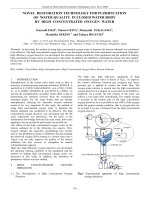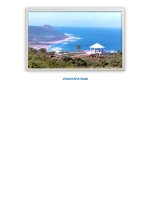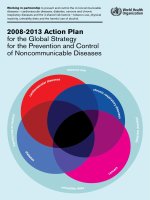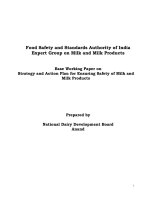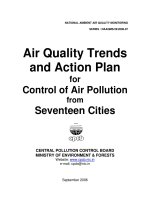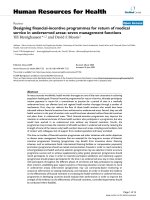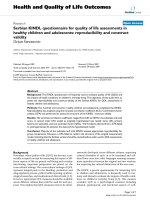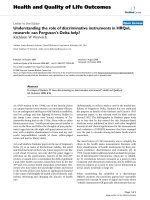FINAL ACTION PLAN FOR IMPROVEMENT OF ENVIRONMENTAL PARAMETERS IN CRITICALLY POLLUTED AREAS “VISAKHAPATNAM CLUSTER” ANDHRA PRADESH docx
Bạn đang xem bản rút gọn của tài liệu. Xem và tải ngay bản đầy đủ của tài liệu tại đây (372.97 KB, 36 trang )
VISAKHAPATNAM
0
1
FINAL ACTION PLAN
FOR IMPROVEMENT OF
ENVIRONMENTAL PARAMETERS
IN
CRITICALLY POLLUTED AREAS
“VISAKHAPATNAM CLUSTER”
ANDHRA PRADESH
NOVEMBER 2010
A.P. POLLUTION CONTROL BOARD
PARYAVARAN BHAVAN, A-3, IE, SANATHNAGAR, HYDERABAD
www.appcb.ap.nic.in
2
PREFACE
CPCB has evolved a Comprehensive Environmental Pollution Index (CEPI)
for 88 study areas with an objective of identifying polluted clusters or areas in
order to take concerted action and to centrally monitor them at the national level
to improve the current status of their environmental components such as air and
water quality, ecological damage and visual environmental conditions. As per the
study of CPCB, Visakhapatnam area was considered as critically polluted area.
The Steering Committee of CPCB, New Delhi on CEPI reviewed the draft
Action Plan of Visakhapatnam
cluster of Andhra Pradesh State on July, 2010
and gave certain suggestions / comments. Taking into consideration the
suggestions / comments made by the steering committee, a revised action plan
was prepared by APPCB and submitted to the CPCB.
The MoE&F reviewed the APPCB action plans for Visakhapatnam Areas and
continued in the list of the Critically Polluted Areas vide MoE&F Notification Dated
26
th
October 2010.
The Central Pollution Control Board’s In-House Committee reviewed the
revised Action Plans of the A.P. Pollution Control Board on 02.11.2010 for
Visakhapatnam Clusters in the light of the suggestions made by the Steering
Committee in October, 2010 and also on the earlier observations / suggestions
made by the In-House Committee. The meeting was attended by the Board’s
Officials. During the meeting the In-House committee observed that some of the
suggestions of the Steering Committee have been incorporated in the Action
Plans. However, it has sought the Final Action plans for the cluster areas.
Accordingly, APPCB has prepared the Final Action Plan on Critically
Polluted Area of Visakhapatnam cluster taking into consideration the
suggestions made by the In-House committee and the same is submitted to the
Central Pollution Control Board, New Delhi for Consideration.
3
INDEX
Sl.No CONTENTS Page No.
1 Introduction 4
1.1 Background 4
1.2
Status of major polluting Industries during 1992
7
1.2.1
M/s. Hindustan Petroleum Corporation Ltd
7
1.2.2
M/s.Coromandel Fertilizers Ltd.,
7
1.2.3
M/s.Hindustan Polymers (name changes as LG Polymers)
8
1.2.4
M/s.Rain Calcining Ltd, (name changed as Rain Carbon India Ltd)
8
1.2.5
M/s.Hygrade pellets Ltd, (name changed as Essar Steels Ltd)
8
1.2.6
M/s.Visakhapatnam Port Trust
8
1.2.7
M/s.Hindustan Zinc Ltd,
9
1.3
Status of Air jQuality in Visakhapatnam between 1990 – 2009 and 2010
at Annexure-I
9
2.0
Comprehensive Environmental Pollution Index (CEPI)
10
2.1
Remarks of APPCB on CEPI
10
2.2 A map indicating the bowl area which is declared as critically
polluted area is annexed at Annexure-II
10
3.0 Action plan for improvement of Environmental parameters in bowl
area of Visakhapatnam:
11
3.1 Industrial Sector: 11
3.1.1
PLAN OF ACTION:
11
3.1.2
Financial Plans
22
3.2 Sewage Treatment in Visakhapatnam City:
23
3.3 Municipal Solid waste Management
27
3.4 Bio-Medical waste Management 28
3.5 Vehicular pollution Control: 28
3.5.1
Additional Tax on Second Vehicle:
29
3.6 Continuous Monitoring proposals by APPCB 29
3.7
Further Actions proposed
29
4
ACTION PLAN FOR VISAKHAPATNAM BOWL AREA
1. Introduction:
Visakhapatnam is situated in North Eastern Coast of Andhra Pradesh with
a topography like a spoon shaped basin surrounded by hill ranges on
three sides and sea on the other side and is often called as bowl area for
assessment of environmental related issues. The hill ranges cause inversion
conditions particularly in winter season.
Visakhapatnam attracted for establishment of major industries like M/s.
Hindustan Petroleum Corporation Ltd., (Formerly M/s. CALTEX – Refinery),
M/s. Hindustan Zinc Ltd., (Zinc & Lead Smelter), M/s. Coromandel Fertilisers
Ltd., (Complex Fertiliser Plant) etc., due to close proximity to a natural
harbour and sea port.
With the establishment of major industries in the core area of
Visakhapatnam and few more industrial establishments like M/s. Hindustan
Polymers Ltd., (a distillery), M/s. Andhra Cements Ltd., (a cement plant),
M/s. Visakha Co-operative Dairy (a milk dairy) in the sub-urban areas, the
water and air pollution problems aggravated and hence the city
occupied place in the map of pollution potential areas. Major habitations
and industries are co-existing in the bowl area (habitation developed on
surroundings of all major industries).
1.1 Background:
Visakhapatnam is one of the identified problematic areas in the country
due to its vast industrial activities with available harbour facilities and
other infrastructure. At the 29
th
conference of the Chairmen and
Member Secretaries of the Central and State Pollution Control Boards
held at Srinagar, 12 areas were identified as problematic areas in which
Visakhapatnam is one of them. As per the directions of the MoEF, New
Delhi, the CPCB identified the bowl area of Visakhapatnam in Andhra
Pradesh one among the critically polluted areas of the country in April
1989.
The issues considered for declaring Visakhapatnam as critically polluted
area are:
• Ambient Air Quality reached to critical level in respect of SPM, SO2
and NOx.
• Industries contributing significant pollution load in terms of BOD are
Hindustan Polymers and Municipal Waste, while ammonical nitrogen
and fluoride are being contributed by M/s.Coromandel Fertilizes Ltd.
• High concentration of fluoride, nitrate and zinc in the ground water
were found.
5
• There was no systematic and proper disposal of solid waste
generated from Hindustan Zinc Ltd.,
A team from the CPCB visited Visakhapatnam along with their mobile
laboratory during December 1989 and conducted survey both on water
and air pollution. Based on the study, a status report on “Assessment of
the status of Ambient Air and Environmental water quality and pollution
generation in Visakhapatnam” had been prepared.
During the review meeting of the conference of Chairman, Central &
State Boards with MoEF, GoI at New Delhi on 14.05.1990, it was decided to
make Visakhapatnam free from pollution by end of August 1991 and a
special drive shall be made on all fronts such as water pollution, air
pollution, soil pollution, noise pollution and other smell causing problems
etc., in the city and an action plan had to be prepared. The APPCB was
directed to submit a monthly report to the CPCB & MoEF on the progress
in this regard. An action plan covering water pollution, air pollution, noise
pollution, automobile pollution and hazardous waste management in the
Visakhapatnam city was prepared in 1990.
In consultation with CPCB, the Member Secretary of APPCB submitted a
time targeted action plan and communicated to all the following
identified polluting industries during August 1990 and target dates were
fixed.
1) M/s.Coromandel Fertilizers Ltd,
2) M/s.Hindustan Petroleum Corporation Ltd, (Refinery)
3) M/s.Hindustan Zinc Ltd,
4) M/s.LG Polymers (Initially M/s.Hindustan Polymers Ltd),
5) M/s.Andhra Cements Ltd, (initially M/s.Visakha Cements)
6) M/s.Visakha Co-op Dairy,
7) M/s.Visakhapatnam Steel Plant
8) M/s. Visakhapatnam Port Trust
9) M/s.Pragathi Fertilizers (closed)
10) M/s.Coastal chemicals (closed)
11) M/s.Steel Create (closed)
12) M/s.A.K. Corporation (name changed as M/s.A.K.C. Steels Ltd
and it is only steel re-rolling mill)
13) M/s.Andhra Steel Corporation (closed)
14) M/s.Granite stone crushers (closed)
6
The A.P. Govt. vide order dt.30.04.1991 constituted an Expert committee
to look in to the increasing problems of pollution in Visakhapatnam and to
suggest appropriate measures for controlling the pollution with the
following members:
1. Prof. V. Sundaresan, Ex. Director, NEERI.
2. Prof. C.A. Sastry, IIT, Madras.
3. Prof. T. Sivaji Rao,
4. Sri. Gurunadha Rao, Local MLA
5. Chief Town Planner, VUDA
6. Regional Officer, Pollution Control Board, Visakhapatnam,
Convener.
Besides this a District Review Committee under the chairmanship of District
Collector for reviewing the pollution problems in the District had been
formed. Another committee (watch dog committee) under the
chairmanship of Naval Chief for conducting frequent meetings and
highlighting the pollution problems was also constituted.
The Expert Committee visited Visakhapatnam in the month of August 1991
and February 1992 and after discussions with various organizations,
industries and District Officials recommended the following issues to the
state government as well as to the industries.
• The land use classification prepared by Visakhapatnam Urban
Development Authority (VUDA) should be critically reviewed with
respect to ground truth as there is a mismatch between plans and
ground conditions shown in VUDA Master Plan.
• Visakhapatnam Municipal Corporation (VMC) should be asked to
provide an effective sewerage system to collect sewage from
residential and commercial areas and provide effective STP to
reduce water pollution in harbour area. The VMC should prepare a
plan for solid wastes Disposal system and approach the
Government of India for funding.
• Villages viz., Mulagada and Chukkavanipalem adjoining the
M/s.Hindustan Zinc Ltd, should be relocated and rehabilitated in
order to prevent continuous exposure of lead and zinc by the public
which is likely to be emitted even after effecting all control
measures. There are other equally hazardous industries such as
M/s.Hindustan Petroleum Corporation Ltd, M/s.Coromandel Fertilizers
Ltd, etc., which will have combined effect on the health and well
being of the local population, particularly the weaker sections.
7
• The Naval Establishment has constructed multi storied buildings in
industrial area completely violating the local building bye-laws and
exposing resident population directly to Air Pollution. Hence, no
more residential buildings in that zone should be permitted.
• A comprehensive Regional E.I.A should be taken up immediately to
encompass greater Visakhapatnam area, for which all the industrial
establishments should contribute on a pro-rata basis.
• The land use classification prepared by VUDA has been violated in
several locations. Hence, the VUDA master plan should be
implemented strictly and no further violations should be allowed with
respect to land use classification.
• M/s.VPT owns large track of land, which may attract further industrial
activity. In future no polluting industry should be located in the area
under the ownership of the port.
• M/s.VPT should prepare a Master Plan from Environmental angle
before any further decisions are made to locate industries or
commercial activities and get it approved by Ministry of
Environment, Government of India.
• A rational network of Air Quality Monitoring Stations along with Micro
Meteorological Stations is an urgent need. A minimum number of 15
monitoring stations will be required to cover Visakhapatnam. M/s.
Visakhapatnam Steel Plant and other large industrial units such as
NTPC which are coming up outside the bowl area will need
additional stations.
• A.P. Pollutions Control Board should purchase the Mobile Van along
with the laboratory in addition to permanent stations in
Visakhapatnam area to participate in the Monitoring Programs.
• No further polluting industry should be located in Visakhapatnam
Bowl Area. In case additional industries are forth coming, the
Andhra Pradesh Government should create and identify locations
15 Kms, outside the boundary bowl area.
• The large influx of mobile population into Visakhapatnam city area
brings about environmental sanitation problems as well as acute
housing shortages. In order to minimize pollution, adequate
sanitation facilities for the floating population, community toilets
should be provided in a greater number of areas adjoining Railway
Stations, Bus Station, Commercial Complexes, Markets as well as
slum areas.
1.2 Status of major polluting Industries during 1992:
1.2.1 M/s. Hindustan Petroleum Corporation Ltd
8
• In 1992 the refinery was not having sulphur recovery unit when the
crude through put was 4.5 MMTPA.
• The unit was not having ETPs for treatment of the effluents.
• The industry was having major problem on disposal of high oily
sludges and other solid wastes.
• The unit was having odour problems from CDU-I & II due to hot well
off gases.
1.2.2 M/s.Coromandel Fertilizers Ltd.,
• CFL established an integrated fertilizer complex in the year 1964
originality with all facilities to manufacture intermediate products
The industry uses Sulfur, Urea, Rock Phosphate, Ammonia etc., with
related raw materials and intermediates. All the required
intermediate products such as Ammonia, Urea, Sulfuric acid and
phosphoric acid were manufactured captively by M/s. CFL.
• The industry used to cause lot of SO2 emissions during startups from
1400 TPD Sulphuric acid plant.
• The industry was utilizing huge quantities of sea water for sluicing of
Gypsum for wet disposal and there by storing gypsum in 100 acres
without lining and causing of ground water contamination due to
leachate from gypsum storage.
• The industry used to store raw materials openly.
1.2.3 M/s.Hindustan Polymers (name changes as LG Polymers)
• Initially the industry was used to produce ethyl alcohol (distillery),
polystyrene, styrene, expandable polystyrene, toluene using
molasses and benzene. Air and water pollution problems were
there at that time.
1.2.4 M/s.Rain Calcining Ltd, (name changed as Rain Carbon India Ltd)
• Industry is involved in producing calcining petroleum coke (kiln-1 no)
with a waste heat recovery boiler (1 no) and was having Coal Fired
Boiler to produce power as a by product. The main air pollution
sources were SPM & SO2.
• The industry initially was not having dust suppression system and
used to cause fugitive emissions from coke pad areas.
1.2.5 M/s.Hygrade pellets Ltd, (name changed as Essar Steels Ltd)
• The Industry established initially to produce iron ore pellets and the
main raw material required i.e. iron ore fines were being stored in
9
the premises and in the port area and thereby used to cause lot of
fugitive emissions.
• The industry was generating ion ore fines slurry and used to store in
slurry ponds in 10 acres and there were lot of emissions.
• The industry provided only multi cyclones to the indurating furnaces-
2 nos to control SPM emissions.
• The industry initially was not having dust suppression system from raw
material storage areas.
• The industry was not having closed conveyors for finished product
conveyor belt.
• The industry used to cause lot of emissions during power shut downs
and due to process disturbances.
1.2.6 M/s.Visakhapatnam Port Trust
• By 1992 M/s.VPT used to handle 15-20 MMTPA and there was no dust
suppression system.
• The port was storing some of the dusty cargoes very nearer to the
habitations.
1.2.7 M/s.Hindustan Zinc Ltd,
• Initially the industry was having lead plant and was not meeting the
Board standards for the effluents from lead plant.
• The industry was not having de-dusting system to the zinc oxide
plant was not having tail gas treatment plant to the sulphuric plant.
• There was no systematic and proper disposal of solid waste
generated from the industry.
A
A
l
l
l
l
t
t
h
h
e
e
a
a
b
b
o
o
v
v
e
e
i
i
n
n
d
d
u
u
s
s
t
t
r
r
i
i
e
e
s
s
h
h
a
a
v
v
e
e
u
u
p
p
g
g
r
r
a
a
d
d
e
e
d
d
t
t
h
h
e
e
i
i
r
r
p
p
o
o
l
l
l
l
u
u
t
t
i
i
o
o
n
n
c
c
o
o
n
n
t
t
r
r
o
o
l
l
s
s
y
y
s
s
t
t
e
e
m
m
s
s
f
f
r
r
o
o
m
m
t
t
i
i
m
m
e
e
t
t
o
o
t
t
i
i
m
m
e
e
a
a
n
n
d
d
t
t
h
h
e
e
e
e
x
x
i
i
s
s
t
t
i
i
n
n
g
g
p
p
o
o
l
l
l
l
u
u
t
t
i
i
o
o
n
n
c
c
o
o
n
n
t
t
r
r
o
o
l
l
s
s
y
y
s
s
t
t
e
e
m
m
s
s
i
i
n
n
t
t
h
h
e
e
m
m
a
a
j
j
o
o
r
r
i
i
n
n
d
d
u
u
s
s
t
t
r
r
i
i
e
e
s
s
h
h
a
a
v
v
e
e
b
b
e
e
e
e
n
n
g
g
i
i
v
v
e
e
n
n
u
u
n
n
d
d
e
e
r
r
A
A
c
c
t
t
i
i
o
o
n
n
P
P
l
l
a
a
n
n
(
(
p
p
a
a
r
r
a
a
3
3
.
.
0
0
)
)
1.3 Status of Air jQuality in Visakhapatnam between 1990 – 2009 :
1.3.1 National Environmental Engineering Research Institute (NEERI) carried
out air quality studies in Visakhapatnam and the values are given
below:
10
1990 (Winter) – SPM – 117 to 394 ug/M3, SO2 – 6 to 230 ug/M3, NOX – 9
to 18 ug/M3.
1990 (Summer) – SPM – 36 to 326 ug/M3, SO2 – 3 to 45 ug/M3, NOx – 3
to 20 ug/M3 (24 Hourly Average)
2002 (Winter) – SPM – 127.5 to 302.6 ug/M3, SO
2
– 6.6 to 44.8 ug/M3,
NOx – 5.2 to 15.0 ug/M3
2002 (Summer) – 121.7 to 265.6 ug/M3, SO2 – 9.2 to 46.5 ug/M3, NOx –
4.4 to 14.3 ug/M3.
1.3.2 APPCB has been monitoring air quality for the parameters of RSPM,
TSPM, SO
2
and NOx on regular basis at nine locations, out of which
three locations are in the Old Town area.
The annual averages AAQ values from the year 2000 - 2009 are
given at Annexure-I The values reported indicate that except
TSPM, no abnormal values are observed.
1.3.3 APPCB has been reviewing all the industries existing in bowl area from
time to time and various directions have been issued for the
upgradation of the pollution control systems.
As per the directions of CPCB vide Letter dt.23.02.2006, a Committee
has been constituted to review the critically polluted area and
exclusive reviews were conducted on 10.11.2006, 19.04.2007,
15.05.2008, 16.10.2008, 16.12.2008, 06.11.2009 and 25.02.2010.
2. Comprehensive Environmental Pollution Index (CEPI):
CPCB has evolved a Comprehensive Environmental Pollution Index
(CEPI) for 88 study areas with an objective of identifying polluted
clusters or areas in order to take concerted action and to centrally
monitor them at the national level to improve the current status of their
environmental components such as air and water quality, ecological
damage and visual environmental conditions. Visakhapatnam is in the
40
th
place as far as CEPI score is concerned with a score of 70.82. It has
been suggested that areas having aggregated CEPI of 70 and should
be considered as critically polluted areas. Accordingly, Visakhapatnam
is considered as a critically polluted area as per the CEPI score also.
However, the sub-indices for air, water and land for Visakhapatnam are
57.0, 57.05 and 55 only. However, keeping the overall CEPI in view, an
action plan has been prepared for Visakhapatnam in order to put
further efforts by various sectors including industrial sector for pollution
control (para 3.0).
2.1 Remarks of APPCB on CEPI:
11
The data considered and the study period preferred have not been
indicated in the CEPI report. The geographical area of the study area
has not been mentioned. However, the bowl area of Visakhapatnam
has been declared as critically polluted area by MoEF’s Office
memorandum dated 15.03.2010. Certain pockets of Visakhapatnam
especially towards sea coast / creeks were marshy lands and after
reclamation, the industries were established, hence in assessing the
ground water characteristics it is not clear whether this parameter has
been considered.
Visakhapatnam is likely to attract maximum factor under A2 due to
scale of industrial activities which cannot be changed further. it is also
likely to attract maximum factor under C1 due to number of people
residing within 2 KM radius from the industries are more than 1,00,000,
hence, no possibility for change in C1. Similarly, maximum factors are
possible under C3 also (C3=0 if ‘no’ and 5 if ‘yes’ – additional risk to
sensitive receptors within 2 KM distance from the source).
CEPI for air environment of Visakhapatnam is 57.0 with the break up of
A+B+C+D as 15+12+20+10, for water environment as 57.7 with the break
up of 15+12.5+20+10, for land environment as 55.0 with break up of
15+12+18+10. It indicates that in all environments maximum values is
shown under score ‘C’. Hence, this needs to be examined thoroughly.
In the above circumstances, it may be noted that the action plan
would address the contribution of pollution due to air, water, hazardous
waste, solid waste and bio medical waste, sewage pollution, vehicular
pollution etc., to the overall CEPI.
2.2 A map indicating the bowl area which is declared as critically polluted
area is annexed at Annexure-II
3.0 Action plan for improvement of Environmental parameters in bowl area
of Visakhapatnam:
A draft action plan was prepared initially by APPCB for all sectors
including industry sector based on the directions issued by APPCB from
time to time. The industries existing in bowl area have been reviewed at
Member Secretary level and certain directions have been issued. A
stakeholders meeting with industries, Municipal Corporation,
Visakhapatnam Urban Development Authority, Port Authorities, Police
Department, Transport Department, Local experts in the field of
environment etc., was convened on 01.07.2010 under Chairmanship of
the Collector & District Magistrate, Visakhapatnam and action plan
12
was discussed in detail. The stake holders agreed in principle for the
implementation of action plan.
3.1 Industrial Sector:
The following major industries are existing in the bowl area:
1. M/s. Essar Steels Limited
2. M/s. Rain CII India Limited
3. M/s. Andhra Petrochemicals Limited
4. M/s. Hindustan Petroleum Corporation Limited, Visakh refinery
5. M/s. Coromandal International Limited
6. M/s. Hindustan Zinc Limited
7. M/s. Visakhapatnam Port Trust
3.1.1 PLAN OF ACTION:
Table-A
1. M/s. Essar Steels Limited,
The industry receives iron ore fines from Biladilla mines and manufactures Iron ore pellets. It
uses LSHS as a fuel in the furnace, low sulphur and low ash coal in the 25 MW captive
power plant. The industry has provided conveyor belts for transfer of material to port area.
Action Point
Present status Action plan for
improvement with Target
date
A. Air pollution:
a) Stack emissions
from the
indurating
furnaces.
The industry used to operate the
industry with multi-cyclones. It has
provided ESP’s to the induarating
furnaces in the year 2007 with an
investment of Rs. 15 Cr and meeting
the emission norms.
Monitored values:
Pelletasation Plant - I
SPM – 75.7 mg/Nm3 dt: 07.05.2010
SPM – 92.0 mg/Nm3 dt: 08.06.2010
Pelletasation Plant - II
SPM – 89.7 mg/Nm3 dt: 01.02.2010
Captive Power Plant
SPM – 82.4 mg/Nm3 dt: 07.05.2010
SPM – 74.4 mg/Nm3 dt: 08.06.2010
Not required.
b) Transfer points The industry has provided bag filters/ Not required.
13
scrubbers at all the important transfer
points in the year 2008, with an
investment of Rs. 0.18 Cr.
c) Online
monitoring:
The industry has provided online stack
analyser equipment to the indurating
furnaces in the year 2006 with an
investment of Rs. 0.18 Cr.
It has provided one CAAQM station in
order to know the status of pollution
and to operate the plant in an
environment friendly manner.
The industry is in the
process of providing
another CAAQM station,
which is expected to be
installed by March’2011.
d) Green belt: The industry has developed a green belt
of 52 acres and proposes to develop
additional plantation with an investment
of Rs. 0.30 Cr in the vacant space
available.
Plantation Started
B. Water pollution : Not applicable as the industry is
recycling entire water and it is a
negative water balanced industry.
Not required.
C. Solid waste disposal: The industry generates only recyleble
wastes like wastes oils, used oils etc
they are being sent to the authorised
agencies.
Not required.
2. M/s. Rain CII India Limited,
The industry manufactures calcined coke. The industry receives petroleum coke as a raw
material and it is fed to the rotary kiln for calcination. The gases from the kiln are fed to the
incinerator to increase the residence time of the gases. The waste heat from the gases is
used for steam generation and thereby electric power. The off gases from the boiler are sent
to the flue gas de-sulphurization system where the gases are scrubbed with lime solution.
The gases from the FGD are emitted through bag filters.
Action point Present status Action plan for
improvement with
Target date
A. Air pollution:
a. Stack
emissions
from the
kilns.
The industry has provided flue gas de -
sulpurization for the kiln off gasses. It has
provided the incinerator from the gases
generated during calcination. The industry is
generating electricity from the waste heat
recovery. The industry is meeting the
emission norms. Monitored values are given
below:
Not required
14
WHRB – 1
SPM – 62 mg/Nm3 dt: 12.01.2010
SO2 – 36 mg/Nm3 dt: 12.01.2010
WHRB – 2
SPM – 58.5 mg/Nm3 dt: 12.01.2010
SO2 – 42 mg/Nm3 dt: 12.01.2010
b. Stock yards The industry has provided MDSS to all stock
yards. It has provided wind breaking wall all
along the stock yards in the year 2010 on
North side to avoid fugitive dust nuisance.
Not required
c. Road
sweeping:
The industry has procured a road sweeping
machine with a cost of Rs. 0.25 Cr in the year
2004 and cleaning the internal roads.
Not required
d. Online
monitoring:
The industry has provided stack monitoring
equipment to the kilns and has provided two
CAAQM stations in order to operate the plan
in environment friendly manner.
Not required
e. Green belt: The industry has developed a green belt of
25 acres.
Not required
B. Water pollution : The industry generates only cooling water as
effluent. In the past the industry failed to
meet the temperature parameter. In the year
2006, it provided an auxiliary cooling tower
with an investment of Rs. 15 lakhs. After
commissioning the new cooling tower it is
meeting the temperature norms.
Not required.
C. Solid waste
disposal:
Major solid waste generation from the
industry is 98 TPD of CaSO4 sludge from the
flue gas de-sulphurization system. It is being
sold to the brick manufactures.
Not required
3. M/s.Andhra Petro Chemicals Ltd.,
The industry produces 2 Ethyl Hexanol - 166 MTPD, Normal Butanol -78 MTPD, and Iso-
Butanol-8.4 MTPD using the raw materials Propylene- 180 MTPD & Naptha- 90 MTPD. The
industry recently enhanced its production capacity and up-graded the Effluent treatment
plant. At present the ETP is under stabilization phase.
Action point Present status Action plan for
improvement with
Target date
A. Air pollution:
a. Stack emissions
from the stacks.
The industry is using gaseous fuels and clean
liquid fuels for heating purposes. All process
operations are carried out in closed loop and
gaseous leaks, if any, are connected to the flare
Not required.
15
stacks.
b. Continuous
monitoring
The industry has provided the CAAQM station to
monitor the AAQ within the plant with an
investment of Rs 0.35 Cr.
Not required.
c. Green Belt The industry has developed a green belt of 37
acres.
Not required.
B. Water Pollution: The industry generates effluent from the process
and the effluent parameters in the past
exceeded the standards stipulated. Now, the
industry has up-graded the ETP with a cost of
Rs. 2.0 Cr. At present, the ETP is under
stabilization.
The ETP is expected
to be stabilised by
Jan’2011.
C. Solid waste: The industry generates wastes like Oxo- residue,
Rohdium spent catalyst and ETP sludge. Oxo-
residue is being used as a fuel in the plant,
spent catalysts are being sent to the recyclers
for regeneration, ETP sludge is being sent to the
TSDF for disposal.
Not required.
4. M/s. Hindustan Petroleum Corporation Limited, Visakh Refinery
This is a 10 MMTPA Oil refinery which uses both indigenous crude and imported crude. It
has facilities for manufacture of clean fuels.
Action point Present status Action plan for improvement with
Target date
A. Air pollution:
a. Stack
emissions from
the stacks.
M/s. HPCL (Refinery) has installed
three Sulphur recovery units with an
investment of Rs.160 Crores in the
year 1999 to minimize SO2 emissions
and is recovering 2200 tons of
elemental Sulphur per month.
The Refinery has provided 65 TPD of
sulphur recovery unit along with clean
fuel project with an investment of
Rs.80 Crores during 2009.
The industry has connected hot well
off gases of CDUs to the Burners to
minimize odour nuisance during the
year 2007-08.
The industry is using low sulfur fuels
(0.5 by weight %) for their
The Refinery has proposed to
provide flue gas De-
sulphurisation to FCCUs as a part
of clean fuel project to reduce
SPM & SO
2
emissions in the
Ambient Air further with an
investment of Rs.120 Crores.
Target date- March,2011.
16
requirements and ensuring that the
total SO
2
emissions from the refinery
are not exceeding 11.5 TPD.
b. Continuous
monitoring
M/s. Hindustan Petroleum Corporation
Ltd., commissioned online analyzers
to 19 stacks and 3 CAAQM stations
were established to monitor the
pollutants SPM, SO
2
, NOx, HC, CO
with an investment of Rs.5 Crores.
Not required.
B. Water Pollution: The Refinery has constructed ETP-I in
1993 and ETP-II in 1996 to meet the
MINAS standards and it has has
completed Oil Ingress project in 2009
to avoid entry of excess oil into ETP
with an investment of Rs.7.2 Crores
and is meeting the standards .
C. Solid waste:
a. Oily wastes: Oil is recovered since 2002 from High
Oil sludge and Low Oil Sludge, sent to
Bio-remediation pit and the same is
reprocessed. The industry is in the
process of sending the wastes to the
authorised recyclers.
b. other solid wastes : In addition to the oily wastes, the
refinery generates spent catalysts
etc., which can be used for recycle
purpose. The industry is in the
process of sending these wastes to
the authorised recyclers.
5. M/s. Coromandal International Limited,
The industry manufactures Complex Fertilizers, Sulphuric Acid & Phosphoric Acid by using
Sulphur, Rock Phosphate, MOP, Urea and Ammonia as basic raw materials. During 1997, the
industry closed the urea plant permanently and during 1999-2000, the industry closed
ammonia plant permanently.
Action point Present status Action plan for
improvement with
Target date
Stoppage of operation The industry stopped ammonia production
and urea plant in the year 1999.
The industry de-commissioned pressurized
NH3 storage tank and commissioned two
atmospheric storage tanks of 5000 Tons
17
each. The industry is importing NH3
through ships and through a pipeline to the
premises.
During 1997, the industry established
molten sulphur facility and minimized solid
sulphur consumption gradually thereby
avoiding fugitive emissions.
A. Air pollution:
Receipt & transport of
raw materials
The industry provided Screw un loader at
Wharf area to unload raw material of
Sulphur, Rock Phosphate, etc., in place of
Bucket Conveyor with an investment of
Rs.19 Crores. It has a dedicated raod
from the wharf area to the plant premises.
Not required.
Fugitive emissions
from the warehouse
The industry has provided telescopic chute
in the warehouse in the year 2010 with an
investment of Rs. 0.30 Cr.
Not required.
Sulfuric acid plants The industry has revamped 1400 TPD
DCDA Sulfuric acid plant in the year 2002
with an investment of Rs.8 Crores.
The industry provided alkali scrubber to the
300 TPD and 1400TPD sulphuric acid plants
to minimize the emissions i.e., SO2, SO3 &
Acid mist with an investment of Rs.1.65
Crore.
Monitored Values
1400 TPD Sulphuric Acid Plant
SO
2
– 178.1 mg/Nm
3
Dt. 15.02.2010
SO
3
– 38.2 mg/Nm
3
Dt. 15.02.2010
Acid mist ND Dt. 15.02.2010
300 TPD Sulphuric Acid Plant
SO
2
– 200.9 mg/Nm
3
Dt. 15.02.2010
SO
3
– 24.6 mg/Nm
3
Dt. 15.02.2010
Acid mist ND Dt. 15.02.2010
Not required.
Reduction of fuel
consumption
The industry has stopped fuel consumption
in the complex fertilizer plants by installing
air pre-heater by utilizing exothermic heat
generated during reactions, in the year
2006 with an investment of Rs.6.5 Crores.
The industry has Stopped 6MW DG set and
the required power is being generated from
Not required.
18
turbo generator, where the steam
generated from the sulfuric acid plants is
used. The project was implemented in the
year 2005.
Online Monitoring: The industry has provided online stack
analysers to Sulphuric acid plants for
continuous monitoring of SO2 with an
investment of Rs. 0.16 Cr.
The industry has established one CAAQM
station for continuous monitoring of SPM,
RSPM, SO2, Fluorine and ammonia with an
investment of Rs.0.3 Crores.
The industry is proposing
to provide another
CAAQM station in the
premises, which is
expected to be
commissioned by
February 2011.
B. Water Pollution
T
he industry is having an ETP comprising
neutralization and clari-flocculators, which
requires up-gradation.
The industry is
constructing a new ETP
with an investment of
Rs. 16 Cr, which is
expected to be
commissioned by March’
2011.
C. Solid waste
disposal
Gypsum disposal The industry has an accumulated huge
quantity of Gypsum in an area of about 100
Acres.
The industry adopted dry disposal system
of Gypsum and provided lining to an extent
of 5 acres of existing Gypsum pond with an
investment of Rs. 24 Crores during
April’2009 which eliminated huge
generation effluent from the gypsum pond.
The industry has provided HDPE & Geo
membrane liner under the wagon loading
area where gypsum is stored and
transported from, during June 2010, to
prevent contamination due to acidic
seepages in the surroundings with a cost of
Rs.7.5 Crores.
As per the directions of
A.P. Pollution Control
Board the entire gypsum
stored in old yard of
100 Ac shall be disposed
off before December
2010.
(Present accumulation of
Gypsum is about
15,00,000 T and
generation is 6,00,000T.
The industry is disposing
at a rate of 12,00,000 to
14,00,000 TPA. The
industry reported that
they may not be able to
dispose entire gypsum by
Dec’2010 and requested
that it may be extended
for one more year)
Other Solid wastes The industry generates other solid wastes
like spent catalysts, acid residues etc.,
which are being disposed as per the
Hazardous Waste Authorization.
Not required.
6. M/s. Hindustan Zinc Limited
19
M/s. Hindustan Zinc Limited, established in 1977, used to produce Zinc & Lead. Pollution
Problems were more when the lead plant was in operation. As there was no improvement in
the situation, A.P. Pollution Control Board issued Closure Order to the Lead Plant of H/s.
Hindustan Zinc Ltd., on 07.06.1999. Accordingly, M/s. Hindustan Zinc Ltd., stopped the Lead
Plant operation and removed it completely. During 2000, the industry revamped the Zinc
plant and converted its process to Jarosite process.
Action point Present status Action plan for
improvement with
Target date
A. Air pollution:
Receipt & transport of
raw materials
The industry used to receive its raw-
material from mines through wagons. While
unloading it used to cause fugitive
emissions. During 2010, the industry has
stopped receiving its ore concentrate
through wagons and started to receive by
containers.
Not required.
Sulfuric acid plant The industry has commissioned Tail Gas
Treatment Plant (for reducing SO2
emissions after recovery of SO2 in acid
plant) in the year 1991. It has Installed a
new TGT plant for minimizing the SO
2
emissions with an investment of Rs.12
Crores during March’2009. At present stack
emissions are meeting the standards.
Monitored Values
TGT stack
SO
2
– 116.0 mg/Nm
3
Dt. 09.08.2010
Acid mist – ND Dt. 09.08.2010
Not required.
B. Water Pollution
The industry used to discharge treated
effluent into the Meghadrigedda overflow
channel canal. The industry provided RO
system and mechanical vapour
recompression system to recover water
from the effluent and using it in the
process, thereby reducing fresh water
consumption to implement zero discharge
system during the year 2010.
20
The industry has constructed additional
concrete lined storage tank of 2 days
capacity between clarifier and RO plant to
store effluent during RO plant stoppages
and to treat all the effluent through RO
plant during 2010.
The industry has provided water meters
with totalisers at outlet of clarifier, feed to
RO plant, totaliszer at Mechanical Vapour
Recompression (MVR) to monitor the
quantity of effluent treated in ETP during
2010.
The industry has provided HDPE pipelines
to convey industrial effluent from different
plants to the ETP, in place of existing open
drains, during 2010 there by reducing the
chance of ground water contamination.
Solid Waste disposal
Jarosite The industry constructed a secured land fill
for safe disposal of jarosite cake in the year
2000 with an investment of Rs. 10 Cr. It
has provided a new onsite secured landfill
to dispose hazardous wastes generated in
the plant during June’2009 with an
investment of Rs.10 Crores.
Closure of the Jarosite
Pond
The industry has started the work for
closure of the old landfill.
December 2011
Moore Cake
T
he industry has an accumulated storage of
moore cake, which is generated before
2001 in the premises.
APPCB has directed
the industry to dispose
the entire Moore cake
by Dec’2010. (Present
stock of the Moore
cake is about 80,000T
and disposing at a rate
about 2000 TPM. In
addition, the industry
has consigned 5000T
to Chaina and 8000T
to Dabare Zinc
Smelter, Rajastan for
recovery of Zinc.)
The industry has
sought permission to
dispose the
21
accumulated moore
cake into the landfill.
Target date =
December 2011.
Other Solid wastes The industry is disposing of all the
hazardous wastes from the premises as per
the directions of the Board.
7. M/s. Visakhapatnam Port Trust,
M/s. Visakhapatnam Port Trust, Visakhapatnam was established during 1933 in the east
coast of Andhra Pradesh and increased to 25 breaths to handle different types of cargoes in
different forms. A.P. Pollution Control Board is regularly monitoring the Port activities and
issuing directions as and when required. M/s. Visakhapatnam Port Trust has initiated major
projects for mechanization of the cargo handling facilities and clearances are yet to be
obtained.
Action point Present status Action plan for improvement with
Target date
A. Air pollution: M/s VPT is taking measures, with a
view to get improvement in the
surrounding environment and
reduction in levels of RSPM & TSPM in
the Ambient Air.
M/s VPT is carrying out water
sprinkling round the clock with an
increased frequency on all the dusty
cargo handling/storage areas.
Dusty cargo stacking in the areas
abutting residential locality was
stopped.
High capacity trucks were introduced
to transport the coking coal from GCB
to yards duly providing covers,
thereby reducing the movement of
number of trucks and dust fly-off.
M/s. VPT is ensuring that adequate
spare sprinklers are available for
immediate replacement of damaged
M/s. VPT proposes to mechanize the
coal handling at the GCB.
M/s. VPT proposes to isolate the
dusty cargo by constructing a wall
up to a height of 7M and geo-net
above the wall for a height of 4M.
Mechanical Dust Suppression
System will be provided all along
the wall to eliminate the dust
emissions from the stock yard. Wall
construction is going on, the target
date for mechanisation is June’2012.
M/s. VPT proposes to reorganize the
cargo handling in the berths and
stock yards with a view to control
dust nuisance.
M/s. VPT is in the process of
mechanization of stocking, loading
and unloading of dusty cargo like
coal and iron ore to eliminate the
truck movement (about 6000
nos./day), and thus avoid dust
22
sprinklers and to ensure continuous
operation of all the sprinklers.
M/s. VPT has provided water meters
with totalizers to record the quantity
of water used for sprinkling purpose.
VPT has provided truck tyre washing
facility to avoid dust transfer onto
other roads.
M/s. VPT has provided Mechanised
Dust Suppression System at 3 major
stock yards and West Quay Berths
during 2002 with an investment of
Rs.14 Crores. VPT is using treated
sewage for dust suppression.
M/s. VPT has provided geo-net barrier
at General Cargo Berth (GCB) area for
a length of 240 mts with an
investment of Rs.40 Lakhs.
M/s. VPT has provided covering to
conveyor belt to an extent of 100 M
from Junction Houses H7 & H8 with
an investment of Rs.50 Lakhs to
minimize dust emissions.
emanation.
These improvements are expected
to be completed by 2012.
M/s. Visakhapatnam Port Trust &
NHAI completed the flyover
connecting NH-5 and Port with an
investment of Rs. 116 Crores. By
utilizing this flyover, the dusty cargo
truck movement through residential
/commercial areas has been
eliminated.
B. Water
Pollution
VPT provided a 10 MLD sewage
treatment plant for sewage generated
in the city area with an investment of
Rs. 3 Crores. The treated sewage is
being used for dust suppression
purpose in port area.
3.1.2 Financial Plans:
T
T
a
a
b
b
l
l
e
e
-
-
B
B
23
Sl.
No
Name of the
industry
Investment made for
treatment system for
the past ten years
i.e., 1999 to 2008
earlier
(in Crores)
Investment made for
up-gradation of
treatment system
during 2009 – 2010
(including future
proposed investments
(in Crores)
Time Schedule
1. M/s.
VisSakhapatnam
Port Trust
Line of activity:
Handling of
various cargoes.
Rs. 134.0 Cr
Rs. 1125.0 Cr.
June,2012
2. M/s. Essar Steels
Limited,
Line of activity:
Iron ore
pelletization
Rs.26.5 Cr Rs.3.5 Cr March,2011
3 M/s. Rain CII India
Limited,
Line of activity:
Calcination of
Petroleum Coke
Rs.6.5 Cr Rs.1.5 Cr December,2010
4. M/s.Andhra Petro
Chemicals Ltd.,
Line of activity:
Petrochemical
industry
Rs.6.0 Cr Rs.1.95 Cr January,2011
5 M/s. Hindustan
Petroleum
Corporation
Limited, Visakh
Refinery
Line of activity:
Petroleum refinery
Rs.175 Cr Rs.217.2 Cr March,2011
6 M/s. Coromandal
Fertilizers Limited,
Line of activity:
Manufacture of
complex fertilizers
Rs.87.0 Cr Rs.27.0 Cr March,2011
24
7 M/s. Hindustan
Zinc Limited,
Line of activity:
Manufacture of
Zinc
Rs.16.0 Cr Rs.40.0 Cr December,2011
3
3
.
.
2
2
S
S
e
e
w
w
a
a
g
g
e
e
T
T
r
r
e
e
a
a
t
t
m
m
e
e
n
n
t
t
i
i
n
n
V
V
i
i
s
s
a
a
k
k
h
h
a
a
p
p
a
a
t
t
n
n
a
a
m
m
C
C
i
i
t
t
y
y
:
:
Sl.
No
Particulars Present status of pollution
control systems
Action plan for further
improvement.
Time
Schedule
Grater
Visakhapatnam
Municipal
Corporation
(GVMC)
•
M/s.VPT has provided 10
MLD sewage treatment
plant in the port area for
handling & treatment of
sewage generated from
part of Visakhapatnam
city. The treatment is
based mainly on
activated sludge process.
•
The entire area of GVMC
has been divided into 20
sewerage blocks for the
sake of taking up of
sewerage system in the
city in a phased manner.
•
The area of GVMC is 530
Sq.Kms. and the
population as per 2001
census is 14.35 Lakhs. The
sewage generated at an
average of 100lpcd is
143.50 mld as per 2001
census.
•
The population covered
so far with UGD system
comes to nearly 22.15%
and the length of
sewerage net work
covered is 212.00Kms.Two
STPs of 25 mld(Rs.10.00
•
The project of providing
sewerage system to
central part of
Visakhapatnam city
under JNNURM has been
taken up in four
packages and is in
progress. Nearly 37.15% of
GVMC population (2001
census) will be covered
after completion of the
project. The length of
sewerage net work that is
being covered is 400.00
Kms. Two STPs of 13 mld
capacity (nearing
completion) and 108 mld
capacity are being taken
up in this project. The cost
of the above STPs is
Rs.10.50 Crores & Rs.47.00
Crores respectively.
•
The Detailed Project
Report for Gajuwaka,
Malkapuram and Yarada
covering nearly 23.00 %
of population of GVMC
(2001 census) at an
estimated cost of
Rs.386.10 Crores was
submitted to Govt. of
Decembe
r,2010
